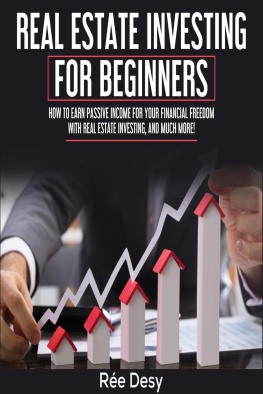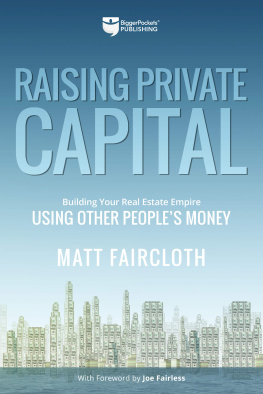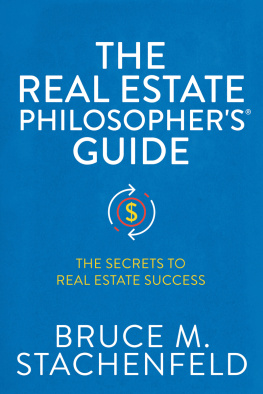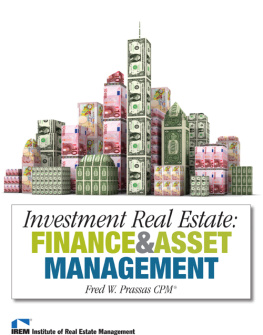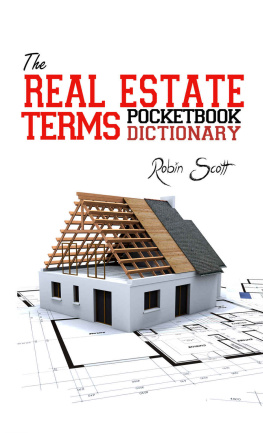
UNDERSTANDING PRIVATE REAL ESTATE
An expert introduction to the fund and asset lifecycles
Published in July 2012 by
PEI
second Floor
sycamore House
sycamore street
london EC1Y 0SG
United Kingdom
Telephone: +44 (0)20 7566 5444
www.peimedia.com
2012 PEI
ISBN 978-1-908783-11-0
eISBN 978-1-908783-55-4
This publication is not included in the CLA Licence so you must not copy any portion of it without the permission of the publisher.
All rights reserved. No parts of this publication may be reproduced, stored in a retrieval system or transmitted in any form or by any means including electronic, mechanical, photocopy, recording or otherwise, without written permission of the publisher.
The views and opinions expressed in the book are solely those of the authors and need not reflect those of their employing institutions.
Although every reasonable effort has been made to ensure the accuracy of this publication, the publisher accepts no responsibility for any errors or omissions within this publication or for any expense or other loss alleged to have arisen in any way in connection with a readers use of this publication.
PEI editor: Helen Lewer
Production editor: William Walshe
Printed in the UK by: Hobbs the Printers (www.hobbs.uk.com)
Figures and tables
Figures
Tables
Introduction
Welcome to PEREs specialist publication, Understanding Private Real Estate, which has been specifically tailored to inform and educate all practitioners, across all specialisms in all markets.
The publication is an invaluable reference companion for any professional for those either working in private equity real estate or looking to move into this space seeking an informed and insightful expert introduction to the fundamentals of investment management in this dynamic asset class.
Perhaps youre a new entrant to the real estate market or a junior-level practitioner. If so, Understanding Private Real Estate gives you a comprehensive practitioners guide to the asset and fund lifecycles. The publication is designed to help you develop a clear understanding of the mechanics and processes involved at each key stage: raising a private real estate fund; sourcing capital from investors; learning how to value commercial real estate; successfully exiting an investment and winding down a fund.
For the more experienced private real estate professionals among you, the publication presents an excellent opportunity to refresh your understanding and benchmark your expertise, as well as broadening your overall knowledge to complement your field of expertise.
Each of the ten chapters which follow is authored by one or more leading practitioner in the private real estate industry. Each expert shares his or her insight and extensive knowledge of their area of specialism to bring each topic to life and to make it relevant to your overall understanding of private real estate.
In the first chapter, Charles Conrath of J.P. Morgan Asset Management and Kasia Sielewicz of DTZ co-author a comprehensive overview of the global private real estate asset class. They highlight the principal investment strategies employed by fund managers, typical fund structures and the key risks an investor in the asset class can expect to encounter. With an eye to the future, they also counter that deleveraging in the financial sector and a series of regulatory changes, such as the Alternative Investment Fund Managers Directive (AIFMD), are likely to alter the way that private real estate funds operate going forward.
Alan Patterson of AXA Real Estate Investment Managers examines real estate investing in the context of cyclical markets. His chapter also analyses investment trends and drivers across regional markets the US, Europe and Asia in the office and retail spaces and considers the implications for investors. Patterson also discusses the outlook for 2012 and beyond and which investment strategy is most likely to appeal to investors and why.
In , Lori Campana of Monument Group presents a highly practical eight-step guide to sourcing capital for a private real estate fundraise. This covers developing and preparing the marketing plan, putting together an investor pitch through to the final investment stage. The chapter also identifies the key constituent parties likely to be involved in a fundraise and defines their specific roles.
Andrew Yoon and Sonny Kalsi of GreenOak Real Estate introduce in the different types of capital used by private funds to finance an investment in real estate assets. They also include a series of useful case study scenarios to illustrate the impact both positive and negative of different levels of leverage on cash flow and equity returns for investors.
Chapters five and six cover different aspects of real estate asset valuation. Ollie Saunders of Drivers Jonas Deloitte takes a detailed look at the role of the valuer and at the appraisal process used and methods employed to reach a judgement on the value of an asset.
In , Phillip H. Gainey, of the Royal Institution of Chartered Surveyors (RICS), goes on to discuss in more detail the three main approaches to valuing the real estate asset the market, cost and income approaches. The chapter also sets out the sensitivity assumptions (such as refurbishment to assets, interest rates and lease terms) that can affect the value of an asset and must ultimately be factored into the real estate appraisal process.
Before deciding to commit capital to a fund, investors naturally want to find out as much information about the manager as possible, including how the managers business is structured, past investments made and performance track record. Hawkeye Partners discusses these topics surrounding the due diligence process in . This chapter also identifies some of the critical legal terms for investors when negotiating agreements with real estate fund managers.
For an insight into the asset management process, , written by Nigel Wheeler of Jones Lang LaSalle, explains the role of the asset manager and the three key components of a successful asset management strategy maximising income, minimising operating costs and risk management.
In , Deborah Lloyd of the law firm Nabarro LLP examines the key issues and considerations at the final stage in the lifecycle of a private real estate fund the dissolution process and exit strategy.
For a glimpse into the future of the private real estate industry, Derek Williams of Russell Investments reveals in what he believes will be the top ten trends and issues most likely to shape and influence the asset class and funds over the next decade to 2022.
Towards the back of the book youll find a useful Glossary which is included to enable you to access quickly many of the financial and real estate-related terminology used in the chapters.
Finally, PERE wishes to extend its appreciation to all the authors for their time and effort contributing to this publication.
Helen Lewer
PERE
Private real estate: A global overview of the asset class
By Charles Conrath, J.P. Morgan Asset Management and Kasia Sielewicz, DTZ
This chapter:
Presents the four quadrants of real estate private equity, private debt, public equity and public debt.
Next page


